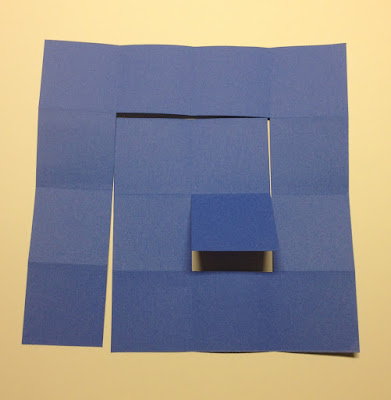This is a long overdue post so I want to give you a free tutorial!
I recently taught the Snake Book to kids at Camp Tannery Arts. This is the fourth year that I have taught at this Camp and every year I do something different. Each year I start out with inviting the kids to my studio and showing them some books from around the world made using different structures and materials. Each year I end with showing them this children's book from Japan:
And, each year I say "we should do this structure next year" and then I forget and come up with something different.
Well, this year I finally remembered and this is the project that I taught the kids. The structure is called a Snake Book
and it is a wonderfully dynamic book that can be read in many different
ways and works great with images and words, or just images. This
children's book tells a story, without words, of a little fish who gets
lost and swims in and out of the holes in the structure, encounters many
creatures, some scary, some funny, and then finally finds his/her
parents at the end.
I love this book for its non-linear reading. It can be turned in a number of different ways to progress through the story. Book artists have utilized this structure to create very sophisticated artists' books, but it is also a great project for kids.
Here is how to make one:
These are the materials you will need: a square piece of paper (any size but this is 12 x 12), pencil or pen, scissors, glue stick if you want covers, and two cover pieces if you want them (see end of project for cover pc. sizes).
Start out with your square piece of paper.
Fold the paper in half and crease.
Unfold paper and meet one of the edges to the center fold and crease, then unfold the paper and meet the other edge to the center fold and crease.
Unfold, and your paper should look like this with three folds and four columns.
Do the same thing in the opposite direction.
Now you should have a square piece of paper divided into 16 smaller squares.
Take a pen or pencil and draw a spiral on the fold lines like this (three squares up, two squares over, two squares down, one square over, and one square up):
Take scissors and cut where you have drawn that spiral.
Take one end of your Snake Book and start folding it back and forth accordion style.
You can call your Snake Book finished now but if you want you can create covers for it. If you want to do that cut them the same size as the small folded squares, apply glue to the cover and glue to each end of the snake book.
Voila, a Snake Book. I love the wonky quality of this book.
I've included this structure in many adult book arts courses that I have taught throughout the years but this is the first time that I have taught it to kids and I was so pleasantly surprised at how well they did. There is a lot of folding, creasing, cutting, and general direction following but they did great and had fun with it. I would say this is appropriate for ages 6 and up and possibly younger with some extra supervision.
Here are some pictures of them in action:
I can't wait to see what they do with the covers and pages: stories, words, pictures? I will find out later this week at the end of camp and might update this post with some shares.
Kids love making books! This is a perfect project for the summer when kids are home and out of school, or if you are teaching summer camp yourself. Please share!
Here are some other tutorials and classes for making books with kids:
Add beautiful covers with Orizomegami
Happy Summer!






















Great project! Making books is fun, whether you're young or old. I bet you could use a circle paper punch to do a similar book with some holes throughout.
ReplyDeleteWhat is the name or ISBN number for the Japanese book?
Thanks!
Great project! Making books is fun, whether you're young or old. I bet you could use a circle paper punch to do a similar book with some holes throughout.
ReplyDeleteWhat is the name or ISBN number for the Japanese book?
Thanks!
Nice Information
ReplyDeleteCalifornia Home Purchased
Great readding this
ReplyDelete